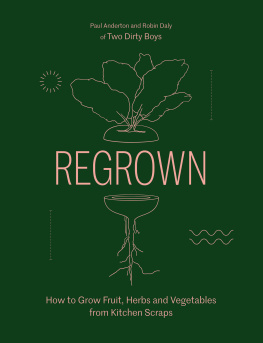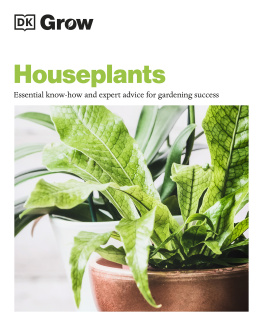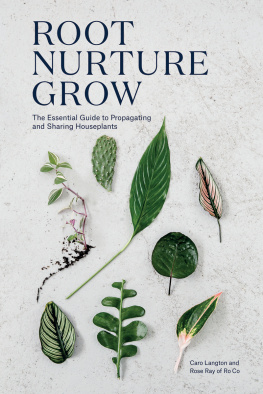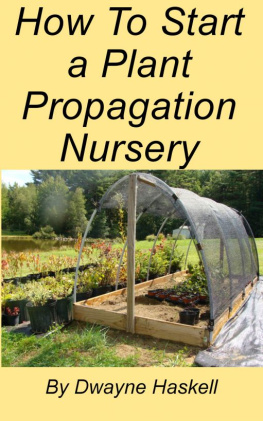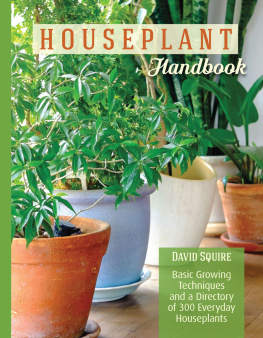
There are two main types of propagation and in both instances we are trying to fool the plant into thinking there is a natural process taking place.
Sexual propagation
This term is used to describe propagation from seeds and spores. This occurs through fertilisation and youll see we explore this with a Peace lily, a Harts tongue fern and an Echeveria succulent.
Asexual propagation
Plants dont need to be fertilised to generate new versions of themselves. Throughout the book weve tried to explore a wide variety of methods to do this. Broadly speaking they take the form of cuttings (leaves, plantlets, tips, stems or side shoots etc.), simple division of roots, or various types of layering where the new plant remains partially attached to the mother plant while growing new roots.
Of course, in nature no plant is cut by a sterile knife, potted into a water-filled glass jar or placed in a plastic bag. Yet each of these stages mimics something that happens in nature. Plants have evolved to use damage, drought, their seeds being eaten whatever it might be to their advantage. In fact, these setbacks help them to spread, thereby increasing the species chances of survival.
In the wild, nature can launch a million experiments in propagation every day, but you may have only a handful of cuttings, or perhaps as few as one very precious but poorly-looking stem. Therefore, when we propagate, were aiming to increase our chances of success by hijacking the cuttings natural ability to regrow, and by putting it into near-perfect conditions.
Some plants propagate very easily. Theyre usually the vigorous kind, both in the wild and as houseplants. Coming from wet and warm tropical climates, where plants and animals compete for survival in natures biological hothouse, these plants are used to being rained on torrentially and therefore forced to fight off waterborne infection. For that is the propagators biggest enemy. The last thing anybody wants is for their cherished cutting to succumb to rot before it has a chance to lay down its roots. Much of each projects focus is preventing rot, and thats why youll read many references to sterile equipment, so lets start there.
Sterilisation
Something is considered sterile when it has no bugs or germs living on its surface. A knife or jar can look spotlessly clean but be teeming with microscopic life. We use sterilisation to minimise the chance of these unwanted pests taking over your propagation project and killing your vulnerable fresh cutting. You can sterilise your equipment in three ways. Whichever method you choose, we dont recommend sterilising anything until shortly before youll use it, otherwise airborne germs will undo all your good work.
1. Chemical sterilisation
Surgical spirit (known as rubbing alcohol in the USA) will kill all known germs dead, so its a very effective steriliser. Itll kill your cutting, too, so it should be used only on your equipment and surfaces. Rub clean cotton buds (Q-tips), or paper towels, dipped in the alcohol over the surfaces you wish to sterilise, then leave to air-dry for a few minutes.
2. Warm soapy water
Many projects require little sterilisation beyond the knife blade. However, your equipment should be kept as clean and free of disease as possible, so for tools and equipment not specified, a careful wash (or a hot dishwasher programme) with warm soapy water should do the trick.
3. Temperature
Larger pieces of equipment and, especially, your growing medium, cant be sterilised with alcohol, so we tend to use the baking or boiling method for jars, lids, terracotta or ceramic pots and so on, and the baking method for potting mix.
To sterilise potting mix, place as much of it as you will need for your project into a deep baking tray (baking pan) and wet until damp all the way through. Then, cover it tightly with kitchen foil and bake in the oven. The length of time will depend on how much you are sterilising. You must make sure that the middle of the potting mixture has reached a sustained temperature of at least 72C (160F) 15 minutes should be long enough. This will kill any bugs and germs. Weve found that, as a general rule, 2kg (4lb 8oz) compost should be baked in the oven at 160C (320F, Gas 4) for 90 minutes.
Sterilise non-plastic items by pouring boiling water over them or using tongs to lower them into a pan of boiling water. A quick submersion in a rolling boil will sterilise anything heat-safe.
The propagator
Each project uses what is called a propagator, which is really just the term for the container that protects the cutting while it takes root. Some are as simple as a glass jar; other projects require a terrarium (we use a plastic storage crate), hermetically sealed (meaning airtight) from the outside world. The more complex propagator is designed to maintain a particular environment to increase the chances of the cutting taking root. Propagators create the ideal environment for the cutting, so they often inadvertently also make the perfect conditions for unwanted pests, bacteria and fungi. For this reason, the propagator should be kept as clean as possible, and a thorough sterilisation is a good place to start.
The growing medium
Weve largely stuck to two types of growing medium for the projects in this book. You may have read about many more, and people do swear by a host of carefully tweaked and adapted recipes, but we have found that the most important characteristics of a growing medium are drainage and moisture retention. These differ in two main ways between propagations, depending on how moist the cutting likes its growing medium to be.
1. Tropical cuttings (that is to say, most houseplants) and plantlets potting mix
These plants require a moist environment, as you find in the rainy, tropical habitats in which they evolved. Being naturally doused in heavy rain and then dried out by hot sun means they prefer a well-drained potting medium that holds some water. Five parts peat-free compost to two parts vermiculite (a natural mineral that both aerates the medium and retains water) is ideal.
2. Cacti and succulents perlite mix
These plants need a mixture that is equal parts (50/50) peat-free compost and either gardeners sand or perlite. This will ensure that any water is quickly drawn away from the developing succulents, mimicking the drought-with-occasional-rain pattern of watering they would receive in the wild.
Its worth noting that both these blends and a range of more specific growing media can be found at garden centres or online. Dont feel youre letting anybody down by not making your own we often buy ours, and simply sterilise it at home as a precaution.
In addition, weve used coco coir (a by-product of the coconut industry) as a replacement for sphagnum moss, which isnt sustainably farmed. Coir is a fibrous material that is perfect, when wet, for the earliest stages of some plants root propagation. As youll see, once the roots have developed, the plants will need placing in potting mix, as coir is nutritionally poor.
Lastly, vermiculite plays an important role in a number of propagations as an additive to the potting mix. It can also be used on its own, as it is the ideal sterile rooting medium thanks to its invaluable water-retaining properties.
A quick note on language weve avoided using the near ubiquitous word compost as it is applied to many different growing media and can get confusing. The only time well use compost is to describe shop-bought peat-free compost, just as youd get from a garden centre, and regularly (but not always) labelled as compost. We use a general, good-quality peat-free compost. This is perfect for most propagations at the potting-on stage once the cutting has rooted well and is ready to be potted on individually.
Next page

